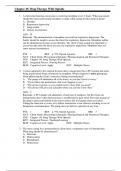Exam (elaborations)
Chapter 49: Drug Therapy With Opioids Test Bank For Abrams' Clinical Drug Therapy: Rationales for Nursing Practice 12th Edition, Geralyn Frandsen
- Course
- Institution
- Book
Chapter 49: Drug Therapy With Opioids Test Bank For Abrams' Clinical Drug Therapy: Rationales for Nursing Practice 12th Edition, Geralyn Frandsen
[Show more]



